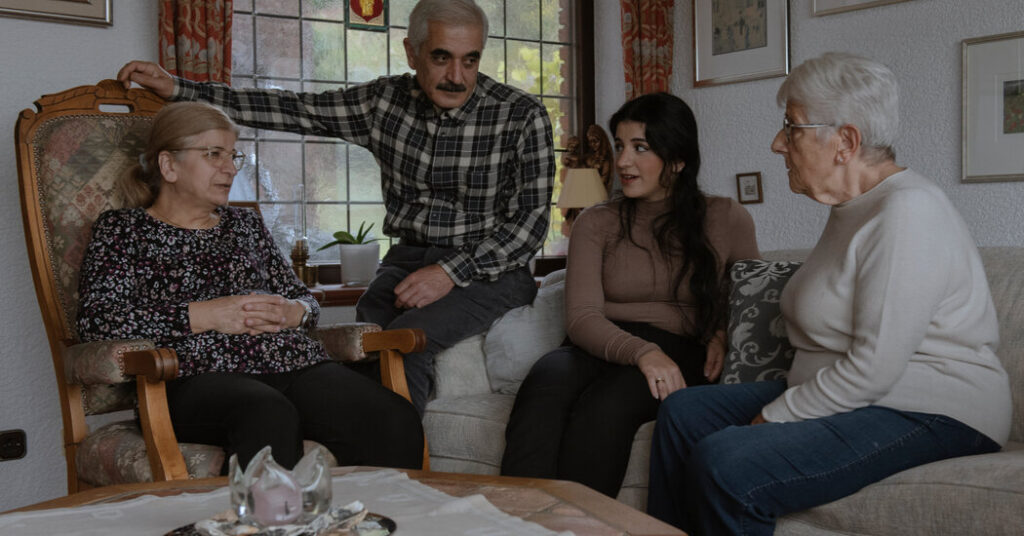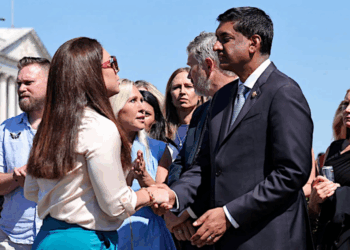Sabri Alban needed seven tries to cross from Turkey to Greece after he fled Syria, and then five more to cross from Greece to Italy. He lost 30 pounds. After six months he reached Germany, where he had heard the schools would be best for his children. He landed in a small town in the western hills, called Daun.
When Bashar Amin arrived from Syria, he also first headed west. But then he moved to Leipzig, a large city near the eastern border with Poland. There, he settled into a life more difficult than he expected when he left behind his war-torn home.
Over the course of a decade, Mr. Alban and Mr. Amin discovered a stubborn fact about their new home. Thirty-five years after reunification, economic success in Germany is still heavily dictated by geography.
It is an inequality that has plagued native Germans since the end of the Cold War. New research shows it has haunted immigrants, too.
More than a million refugees have arrived in Germany since Angela Merkel, the former chancellor, encouraged Germans to open their arms to asylum seekers fleeing the Syrian civil war in 2015, saying, “We can do this.”
Some asylum seekers followed family or friends in choosing where to settle. Others went where the German government sent them, through a policy that sprinkled some throughout the country using a formula based on population and tax revenues. The policy remains in place today.
But over the decade since the first wave arrived, refugees who landed in the former West Germany have done better than those who settled in what was East Germany.
Mr. Alban, who was sent by the government to the western region surrounding Daun, found a community where jobs were plentiful and many locals opened their arms to refugees. The transition was rocky at times. But he and his wife found work, and their children grew up to finish secondary school, start careers and speak fluent German.
“I always say I was born a second time in Daun, and I’m staying here,” Mr. Alban said on a recent evening, sometimes fighting back tears on a break from his work at a senior center. “Walking the streets of town, I greet people and they greet me back. In those moments I think, ‘This is my hometown.’”
Mr. Amin was initially sent to the West, too, but he chose to move east because he had friends there. In Leipzig, he has struggled to master German and to find work. He has noticed growing public hostility to migrants.
“In the beginning it was easier, people were a bit more open,” he said, “and now it has become more difficult or more closed.”
Incomes are significantly lower in eastern states, and unemployment is worse. The rate in the state of Saxony, where Leipzig sits, remains about 1.5 percentage points higher than it is in Rhineland-Palatinate, where Daun is.
Research by German economists shows that refugees who landed in the East over the last 10 years found fewer jobs and lower pay than those in the West. Refugees in the East were also more likely to encounter local opposition to their arrival, including more support for the anti-immigrant Alternative for Germany party, or AfD.
Anecdotal evidence suggests the countries’ newest arrivals, like Serhii Pashchenko and his family, who came from Ukraine in 2022, have found similar divides. In Leipzig, Mr. Pashchenko has had difficulty learning German, which he must do before he can apply to a work-training program. For now, they remain on public support.
On the whole, the asylum seekers who arrived in Germany a decade ago now work at nearly identical rates to native-born Germans, when self-employment is included.
They also appear to be prospering more than refugees in any other European country, said Herbert Brücker, an economist who heads migration research centers at Humboldt University Berlin and the Institute for Employment Research in Nuremberg, and an author of the research finding the regional divide.
But “there is still a substantial distinction” between the economies of the former East and former West Germany, as well as the outcomes for refugees settling there, he said. The former East Germany remains poorer than the West, despite large federal spending efforts over more than three decades.
Immigrants spend and work enough to boost local economies all over the country, Dr. Brücker said. But, he added, “Sending people to a less prosperous region in eastern Germany, more rural with less population, of course you can get problems.”
Mr. Amin, who owned a bakery and a tire shop in Syria, said that in Leipzig, he had found jobs elusive and some neighbors unfriendly.
After working two years in a grocery store, he is now unemployed and has grown discouraged by the lack of opportunity. He longs to own a business again.
“I would like a shop — that is better for me — but I’m looking for a taxi driver job,” he said.
He has not contemplated moving back to the West, he said. But he has considered what once seemed unthinkable: returning to Syria.
Osman Al-Ansarey, 38, who arrived in Leipzig from Libya in 2015, has also found the local job market difficult. He lost his job as an I.T. specialist in August when his contract ended. He recently started working as a cleaner.
In contrast, Daun’s mayor, Thomas Scheppe, said that the surrounding area, in the West, struggles to find enough workers, even with the influx of migrants from Syria, Ukraine and elsewhere.
“Jobs are not a source of conflict here,” Mr. Scheppe said.
In Syria, Mr. Alban worked as an assistant to an anesthesiologist. After moving to Daun, he retrained in elder care. He learned German and since 2015 has worked in a residential senior center.
His family, who are Kurdish Muslims, were some of the first refugees to arrive in town. It was not always easy. Their youngest daughter, Jian, now 20, says she was bullied in school. Her older sister Joudi, now 27, was sent down several grades from where she had been in Aleppo.
Despite difficulties, in East and West alike, refugees said some locals had smoothed their economic and cultural transition over the last decade.
Inside a repurposed old train station in Daun, volunteers at a refugee assistance center called Café Asyl teach German classes and help refugees navigate the country’s stifling bureaucracy. One volunteer became a confidant and cheerleader for the Alban family.
“I didn’t have an uncle or aunt here, but I had someone who helped me and looked out for me,” Jian Alban said. “I used to tell him everything that happened at school, and he always encouraged me: ‘Keep going, and once you finish school, they’ll all be surprised. They’ll say, look, she came to Germany in 2015 and already has a diploma.’ That definitely helped me a lot.”
Another resident basically became a family member. In 2019, Ms. Alban’s mother, Hanifa Mohamad, began working for Christel and Alfred Deutsch, a local couple. She maintained the house they had built decades before on a hill overlooking Daun.
Mr. Deutsch died in 2022. Ms. Deutsch remained in the home, alone, until the Albans were forced to leave their rental because their landlord wanted to sell it. Ms. Deutsch invited them to join her, an arrangement that Mr. Scheppe, the mayor, says has become a common way for refugee families to cope with the region’s housing shortage.
Ms. Mohamad says Ms. Deutsch is now like a mother to her. Ms. Alban calls her “Oma,” or Grandma.
A few miles away from Daun, in a town called Manderscheid, another set of Kurdish refugees from Syria have opened the only bakery in town, sparing their neighbors a 15-minute drive to buy bread. They also run a restaurant.
Mihan Hasan brought her four children with her in 2016 to join her husband, who had fled for Germany two years earlier. On a recent morning, she joined her eldest son — Jakar, 23 — at the bakery, where a steady flow of locals and tourists stopped in to buy rolls, pastries and fresh loaves of bread.
Mr. Hasan greeted several customers, shaking hands and smiling, like old friends. Many of them were.
“We know a lot of people here,” Mr. Hasan said. “I think if we had been anywhere else, none of this would have been possible.”
Jim Tankersley is the Berlin bureau chief for The Times, leading coverage of Germany, Austria and Switzerland.
The post Old Divides of East and West Haunt Germany’s Newest Arrivals appeared first on New York Times.




